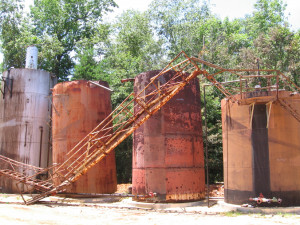An explosion occurred during installation of a connection between 2 hydrocarbon storage tanks in an oil field depot. The installation consists in 4 aligned tanks and connected by a venting system. Tank 1 contains wastewater, tanks 2 and 3 are connected by an overflow system. Subcontractors are about to weld the overflow connection between tank 4 and 3.
Prior to welding, workers removed the hatch at the base of tank n°4 to drain the crude oil residue contained inside. After rinsing with water, they allowed the hydrocarbon vapours to evaporate for several days. Tank n°2 still contained residues and tank n°2 crude oil.
On the day of the accident, one of the workers verified the absence of combustible by inserting a blowtorch inside the hatch, then in the vent of Tank 4 ! In order to provide a platform for the welder, a ladder was placed horizontally between tanks 3 and 4 and was stabilized by 2 workers, steadying on top of one end. A foreman observed the work from the top of tank n°4.
The sunshine and the morning heat favoured the formation and migration of flammable vapors in tanks 2 and 3, which escaped through the overflow 3-inch pipe on tank 3, that was to be collected to tank n°4.
Shortly after they began welding, sparks ignited the flammable vapours at the end of the pipeline. Flames flashed back through the open pipe into the storage tanks n° 3, then n°2 through the overflow pipe, causing the explosions of the 2 tanks and flames to jump over 15 m high. The covers of both these tanks were torn off, landing 15 and 220 m away respectively.
The welder, who was attached by a harness, was seriously injured ; the 3 other workers died. A bystander called the local emergency services, and the police were also deployed to the scene. The fire department applied foam to the burning oil fire inside tank 2 and extinguished the fire in about 30 minutes. Approximately 1000 gallons of crude oil remained inside tank 2 after the incident.
Despite the availability of technical guides, the risk analysis revealed many instances of noncompliance with safety procedures during the hot work. A gas detector should have been used, as use of a welding torch was extremely dangerous. The pipe open onto the adjacent tank should have been covered or insulated before initiating the works or, better yet, the combustible vapours should have been eliminated by cleaning Tanks 2 and 3. Moreover, the subcontractors should have assembled a scaffolding rather than a ladder that needed to be held in place by wedging against. Also, the subcontractor had not established any safety procedures for its employees, while the depot operator failed to impose such procedures.
The operator planned to develop and implement a written set of procedures so as to guarantee safe working methods for both tank cleaning and aboveground hot work.




